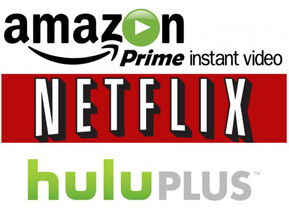Intermittent Issues: I, For One, Welcome Our New Binary Overlords
By Ben Gruchow
November 10, 2016
Audio is considerably patchier; although Netflix offers 5.1 surround on most of its titles, it’s generally working with a bitrate constrained from the original source material. If you remember your basic home-theater audio specs, a Dolby Digital Plus audio track runs at 768 kbps or higher on a Blu-ray disc. Dolby Digital Plus (or DD+) audio on Netflix runs at 192 kbps, justified partly by bandwidth needs and partly by Dolby’s own endorsement of their encoding technology. This results in an effect common to a constricted audio bitrate: dynamic range is suppressed, with the quieter and louder moments situated closer together on the spectrum, and the entire mix tending toward the quieter end, with a noticeably flatter effect in the listening experience.
Amazon chose a different tactic for the launch of its Amazon Instant Video service, launching it in 2011 as an added benefit to its yearly Amazon Prime membership instead of requiring a dedicated monthly membership up front. Other than that, the overlap between Amazon and Netflix as streaming-content providers is striking on the surface - the two got their start at roughly the same time, each of them gained significant additional exposure by partnering with a premium-cable provider, and much of the licensed content is the same across both platforms. Generally, if a movie or TV show is premiering on Netflix in a certain month, it’s also premiering on Amazon. Both providers offer 4K content albeit at different service tiers, and the delivery method is pretty much an apples-to-apples comparison now, too; Amazon offers its streaming content as a standalone service.
The main differences between the two come down to deployment and original content. Amazon offers offline storage; Netflix more or less has a monopoly on the latter. Which one is more valuable ultimately depends on utility; offline storage of movies and TV shows is admittedly useful if you’re going to be spending a lot of time out of normal Wi-Fi or data range, but this is an increasingly rare occurrence, and Amazon is not the only provider to offer this as a function. Netflix’s extensive catalog of original content is more of an asset. Amazon also still lacks iOS or Chromecast functionality, which is so unusual at this stage of the game that it could almost count as a feature. Its interface is generally outdated and unintuitive, and despite offering similar content as Netflix at similar resolutions, actual quality depends more on the device than Netflix does, and the competition has the edge on compatible devices, too.
The final two exhibits in our analysis here depart from the subscription-based model of Hulu, Netflix, and Amazon Instant Video. iTunes and Vudu are both online digital-locker services: it costs nothing to become a nominal member of either of these services, and all of the investment comes in rental or purchase of digital versions of films one at a time. When a user wants to add a film to their online library, they select the relevant option, and their stored payment card is charged; their library is then provided with a key code that acts to “unlock” the product on the provider’s own servers. The key code is either set to expire at the conclusion of the rental period (generally 24 to 72 hours) or set to never expire.
Continued:
1
2
3
4
5
6
7




